
A truffle is the fruiting body of a subterranean ascomycete fungus, predominantly one of the many species of the genus Tuber. In addition to Tuber, over one hundred other genera of fungi are classified as truffles including Geopora, Peziza, Choiromyces, and Leucangium. These genera belong to the class Pezizomycetes and the Pezizales order. Several truffle-like basidiomycetes are excluded from Pezizales, including Rhizopogon and Glomus. Truffles are ectomycorrhizal fungi, so they are usually found in close association with tree roots. Spore dispersal is accomplished through fungivores, animals that eat fungi. These fungi have significant ecological roles in nutrient cycling and drought tolerance.

The Cistaceae are a small family of plants known for their beautiful shrubs, which are profusely covered by flowers at the time of blossom. This family consists of about 170(-200) species in nine genera that are not very distinct, distributed primarily in the temperate areas of Europe and the Mediterranean basin, but also found in North America; a limited number of species are found in South America. Most Cistaceae are subshrubs and low shrubs, and some are herbaceous. They prefer dry and sunny habitats. Cistaceae grow well on poor soils, and many of them are cultivated in gardens.

A chocolate truffle is a French chocolate confectionery traditionally made with a chocolate ganache center and coated in cocoa powder, coconut, or chopped nuts. A chocolate truffle is handrolled into a spherical or ball shape. The name derives from the chocolate truffle's similarity in appearance to truffles, a tuber fungus. It was created in the city of Chambéry by the pastry chef Louis Dufour.
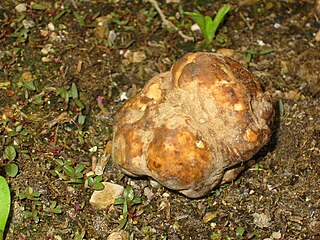
The Terfeziaceae, or desert truffles, is a family of truffles endemic to arid and semi-arid areas of the Mediterranean Region, North Africa, and the Middle East, where they live in ectomycorrhizal association with Helianthemum species and other ectomycorrhizal plants. This group consists of three genera: Terfezia, Tirmania, and Mattirolomyces. They are a few centimetres across and weigh from 30 to 300 grams (1–10 oz). Desert truffles are often used as a culinary ingredient.
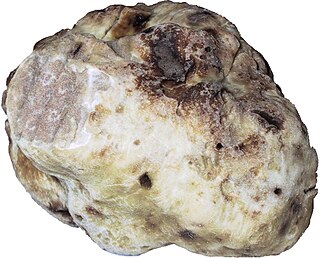
Tuber magnatum, the white truffle, is a species of truffle in the order Pezizales and family Tuberaceae. It is found in southern Europe.

2,4-Dithiapentane is an organosulfur compound. It is a colorless liquid with a strong odor.
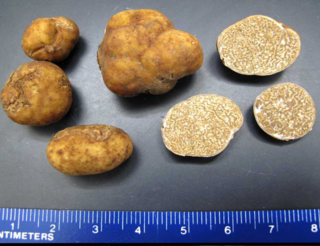
Tuber lyonii, also known as the American brown truffle or the pecan truffle, is a species of truffle native to North America. The pecan truffle is so named because it is most commonly found in pecan orchards, in association with the pecan tree. However, the pecan is not its only symbiote. Formerly considered nothing more than a nuisance by pecan farmers, the pecan truffle has been gaining in popularity as an edible mushroom in recent years and can fetch over $160 per pound at market.
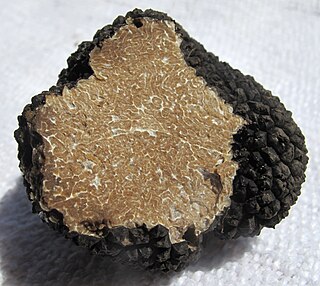
The summer truffle or burgundy truffle is a species of truffle, found in almost all European countries.

Quercus rotundifolia, the holm oak or ballota oak, is an evergreen oak native to the western Mediterranean region, with the majority on the Iberian Peninsula and minor populations in Northwest Africa. The species was first described by Jean-Baptiste Lamarck in 1785. It is the typical species of the Iberian dehesa or montado, where its sweet-astringent acorns are a source of food for livestock, particularly the Iberian pig. Its acorns have been used for human nourishment since the Neolithic era. It is placed in section Ilex. Some authors described it as a subspecies of Quercus ilex.

Tuber oregonense, commonly known as the Oregon white truffle, is a species of edible truffle in the genus Tuber. Described as new to science in 2010, the North American species is found on the western coast of the United States, from northern California to southern British Columbia west of the Cascade Range. A mycorrhizal fungus, it grows in a symbiotic association with Douglas fir. It overlaps in distribution with the closely related T. gibbosum, but they have different growing seasons: T. oregonense typically appears from October through March, while T. gibbosum grows from January to June. The fruit bodies of the fungus are roughly spherical to irregular in shape, and resemble small potatoes up to 5 cm (2 in) in diameter. Inside the truffle is the gleba, which is initially white before it becomes a marbled tan color. The large, often thick-walled, and strongly ornamented spores are produced in large spherical asci. The truffle is highly prized for its taste and aroma. Some individuals have claimed success in cultivating the truffles in Christmas tree farms.

Tuber is a genus in the fungal family Tuberaceae, with estimated molecular dating to the end of the Jurassic period. It includes several species of truffles that are highly valued as delicacies.

Kalapuya brunnea is a species of truffle in the monotypic fungal genus Kalapuya. The truffle occurs only in the Pacific Northwest region of the United States, in western Oregon and northern California. Known locally as the Oregon brown truffle, it was formerly thought to be an undescribed species of Leucangium until molecular analysis demonstrated that it was distinct from that genus. The truffle is reddish brown with a rough and warty outer skin, while the interior spore-producing gleba is initially whitish before developing greyish-brown mottling as it matures. Mature truffles have an odor resembling garlicky cheese, similar to mature Camembert. The species has been harvested for culinary purposes in Oregon.

Tuber microspermum is a species of truffle in the family Tuberaceae. Described as new to science in 2012, the edible species is found in China. The roughly spherical truffle is up to 1.5 cm (0.6 in) wide and yellowish-brown in color. It is distinguished from other truffles by its small asci and small spores that have a network-like surface pattern punctuated by small spines.

Tuber polyspermum is a species of truffle in the family Tuberaceae. Found in China, it was described as new to science in 2011. Fruit bodies of the truffle are small and brown, measuring up to 1.5 cm (0.6 in) in diameter.
Tuber anniae is a species of truffle in the genus Tuber. The truffle is purported to be uncommon, but is primarily found in the United States Pacific Northwest. Recently the fruiting of closely related taxa have been found in the Baltic Rim countries, primarily forests dominated by Scots pine in eastern Finland.

Tuber melanosporum, called the black truffle,Périgord truffle or French black truffle, is a species of truffle native to Southern Europe. It is one of the most expensive edible fungi in the world. In 2013, the truffle cost between 1,000 and 2,000 euros per kilogram.

Tuber donnagotto is a species of truffle in the family Tuberaceae. Described as a new species in 2012, it is found in Croatia. The black truffle measures 2–7 cm (0.8–2.8 in) in diameter.
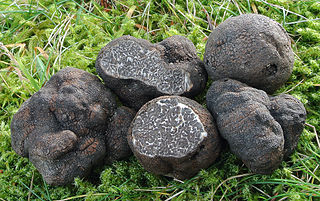
Tuber macrosporum, commonly known as the smooth black truffle, is a species of edible truffle in the family Tuberaceae. Found in Europe, and common in central Italy, the truffle was described as new to science by Italian mycologist Carlo Vittadini in 1831. The truffles are roughly spherical to irregular in shape, and typically measure 0.5 to 2 centimetres in diameter. The surface color ranges from reddish brown to rust to blackish. Warts on the fruit body surface are low, so that the truffle appears fairly smooth. The truffle flesh is purplish brown to grey-brown with thin white veins. It has an intense garlic-like odor similar to the Italian white truffle. Host plants of T. macrosporum include poplars, hazel, linden, and oaks.

Tuber borchii, known as the whitish truffle or bianchetto truffle, is a small, common species of edible truffle excellent for use in cuisine.

Tuber indicum, commonly known as the Chinese black truffle or the Asian black truffle, is an edible fungus known for its hypogean fruiting bodies, characteristic of the Tuber genus. It is found natively in Himalayan India and parts of China, but has also been found invasively in the United States and Italy. It is sold commercially and often confused with Tuber melanosporum.


















